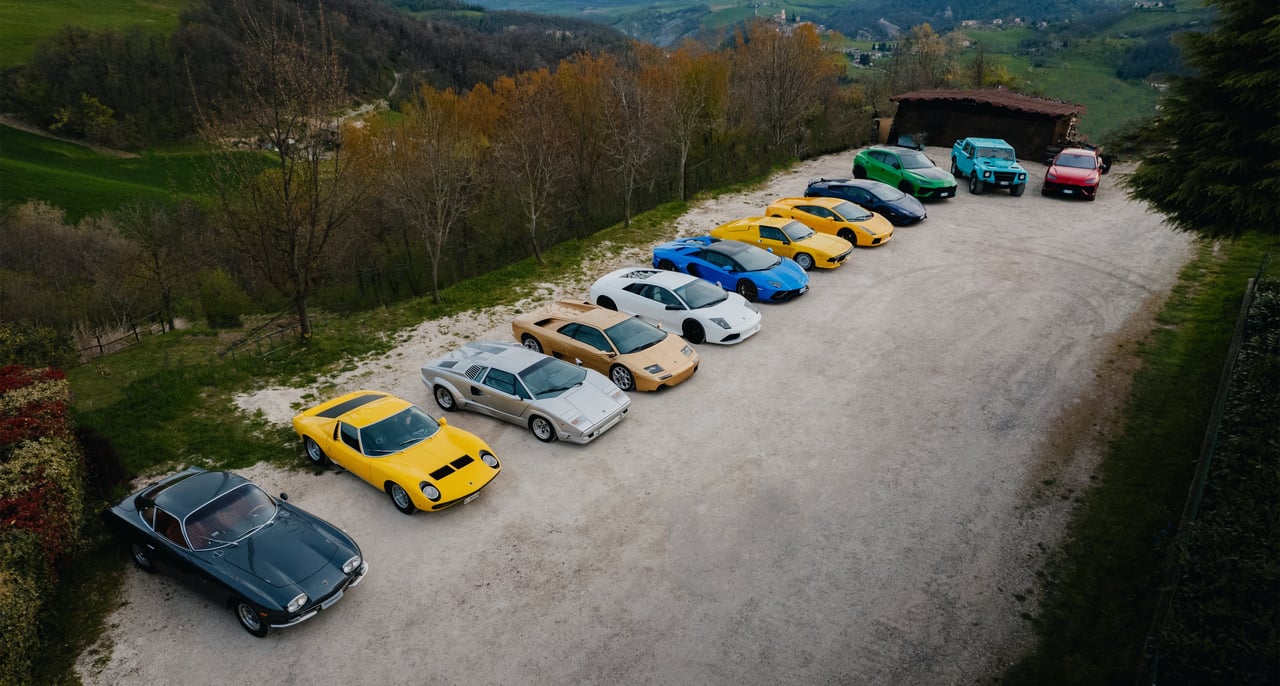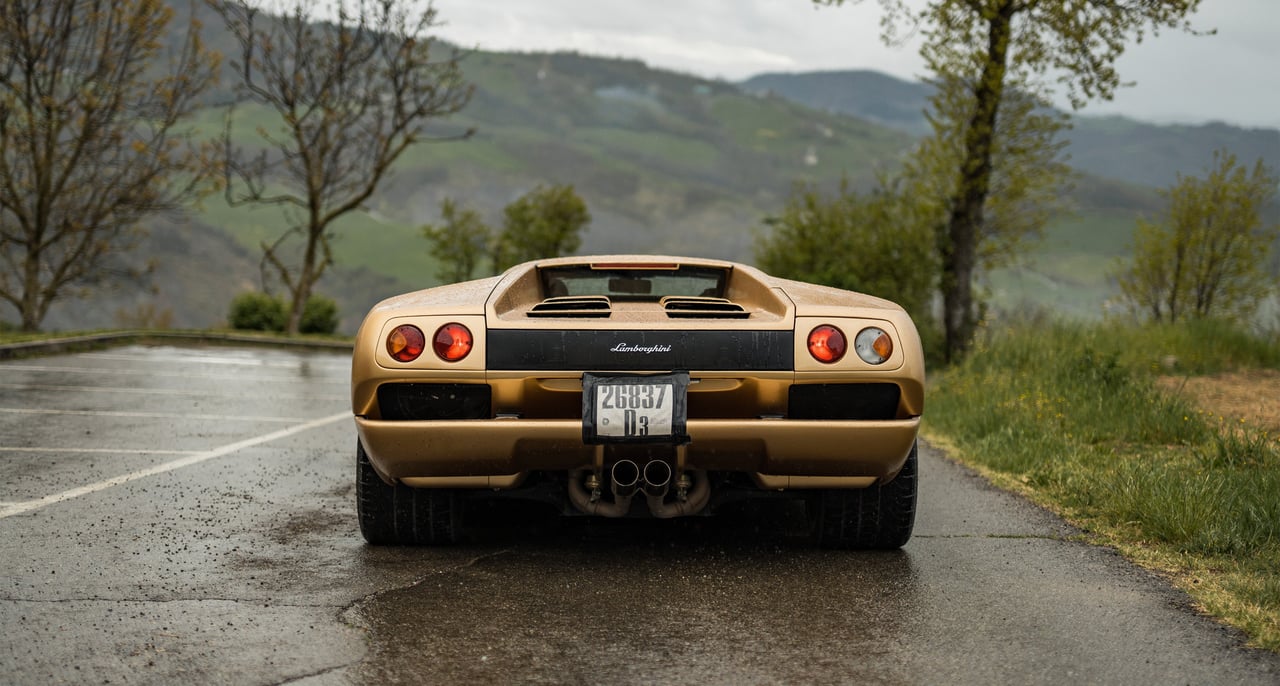
We have a joke here at the Classic Driver office that Wednesdays are better than most other days of the week. The weekend is in sight, and bizarrely it's been a day which has seen some truly wonderful things happen as of late, tearing around Goodwood circuit in the world’s finest supercars for their media day being a particularly notably one. As I landed in Bologna airport and was promptly whisked away to eventually arrive at Lamborghini’s HQ in Sant’Agata, I knew this Wednesday, and the day that followed, would perhaps be the best for a long while.


After a busy first day of in-depth factory tours and brand history lessons, I woke up in Zocca, high up in the hills of the Emilia-Romagna region of Italy, nervous but excited for the ultimate anniversary celebration. I strolled onto the idyllic lawn to discover Lamborghini’s full roster of fire-breathing monsters, from one of the very first, the effortlessly beautiful 400 GT, right through to the last naturally aspirated V12 as we know it, the Aventador Ultimae. But, as I gazed at the mouth-watering array of greats on offer, there were three bulls that I wanted to wrestle, all of which icons in their own right. We'll get to them in a second.

The V12 was the main character in Lamborghini’s story, and during the 1960s, it was the pinnacle of technology and luxury in a sports car, something that Ferrucio was desperate to achieve to rival his fellow Italian car makers. After sustaining better-than-planned success with the 400 GT, the team began to investigate other, slightly more experimental ways to mount the monster, and flipped it 90 degrees, so it was transversely mounted in the middle of the chassis, just behind the driver. Ferrucio was impressed, and apparently exclaimed “I like this one, it’ll earn us legendary status!”. The car he was speaking about was, of course, the Miura.



Finished in Giallo, this was no ordinary 1960s icon, it was a Miura SV, Lamborghini’s first step into creating a more technically advanced version of their regular, still highly enthralling machine. The SV boasted a stiffer chassis, and a rear track which had been widened by 13 centimetres, allowing for better road handling when putting the power down. Traction was also improved thanks to the SV's increased wheel size, as well as its balloon-like 255 rear tyre profiles.


As the sun began to make an appearance, my emotions were all over the place, a concoction of nervousness, pure elation, terror, excitement and just about everything in between. This was, just to add to my apprehension, the very last Miura SV ever made, and if I could describe it by one phrase, it would be this. It was utterly glorious in every single way, and the true essence of what every supercar tries to achieve.

They say you should never meet your heroes. Those heroes may turn out to be older than you think, perhaps a bit more short-tempered and uninviting, they may not live up to the preconceptions you have built up in your mind over the years, and for that, they may leave you disappointed. Whoever uttered that overly used sentence, had clearly never driven a Lamborghini Miura along the breath-taking hills around Italy. As we winded through the twisty lanes following an Urus Performante — a far more comfortable and relaxing driving experience than the 60s legend I was strapped into — the reality of what I was experiencing kicked in. Driving a Miura is something the lucky few who have experienced it will likely never forget, mainly because of the manner in which it must be driven. Its high-revving V12 only comes alive when it decides you are brave enough to experience 385 horsepower straight to the rear wheels, meaning tight, twisty turns are a true test of driving ability in this iconic bull, but one that makes nailing it all the more rewarding. A side note, Cafe Leather's crochet leather gloves have never looked more at home!



Before the elation of driving an icon of the 1960s had subsided, it was time to experience a machine seemingly straight from a science fiction novel. My incredible instructor Pietro Perolini, whose day job is to race Huracan race cars at the highest level, explained to me the many quirks of this frankly ludicrous car. Much like the vibrant Miura SV, this Countach 25th Anniversary Edition was in fact the last ever example produced, leaving the factory on July 4th 1990, a whole 19 years after the first ever Countach burst onto the scene at the 1971 Geneva motor show. This example actually never left Lamborghini and remained as a museum piece. Dark clouds began to litter the sky, making the Argento Metallizzato paintwork gleam like a mirror.

The driving experience of this, compared to that of the Miura, instantly made me understand the Lamborghini brand in its entirety. The marque simply holds no compromises, and driving this Countach again on narrow, undulating roads was a sensory overload. Visibility is non-existent, the lack of power steering is evident to say the very least, but the roar of that 5.0-litre V12 sitting just inches behind your ears blows every quirk into oblivion. A car that looks as bonkers as this has no business being easy to drive, and the Countach takes no prisoners, forcing the driver to stay completely focused at all times.


The experience of driving the poster car of so many around the world felt like it was over in a flash, but the reality was my concentration levels were at an all-time high, they had to be while driving this wide of a machine on such tight Italian roads. As I carefully reversed it into an exceptionally expensive parking space, I glanced across to see my final raging bull ready and waiting. Seeing the elegant lines of the Miura next to the lunacy of the Countach highlights just how quickly Lamborghini developed as a brand, faster than almost any luxury car maker.



The doors lift on the Oro Elios Diablo, and I’m greeted by plush Nero leather and a somewhat restrained interior space compared to the previous two. As I’m sealed into the car and fire up its 6.0-litre V12, the rain starts to pour – yikes. Despite marking the start of AWD systems for Lamborghini, driving a Diablo in wet conditions was not something I’d factored into my mind. Yet, somehow, the Diablo was refined and comforting on the open road, particularly at lower speeds while I followed Pietro in the Urus. That said, bring the revs up to 4 or 5,000rpm and you unleash an entirely different bull, one that is chomping at the bit for some spirited driving. All Lamborghini models are Hollywood icons, but driving this golden Diablo made me think of the amount of screen time Lambos have had over the years, from brief scenes in Dumb & Dumber, right through to being Bruce Wayne’s incognito machine in the Dark Knight.

The truth is, before this trip I’d only admired Lamborghini from afar. I appreciated their designs and respected that iconic engine, but being behind the wheel of the very cars that made them one of Italy’s most loved brands gave me clarity as to why Lamborghinis are the way they are. Unapologetic, deeply passionate, and above all, pure theatre on four wheels!
Photos: Federico Vecchio


























































